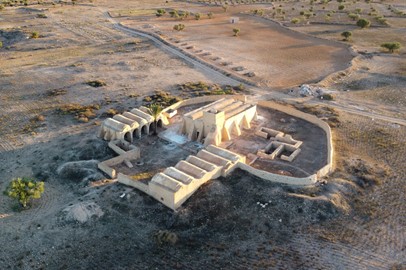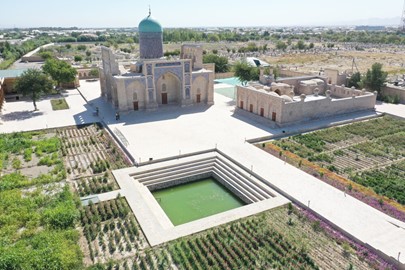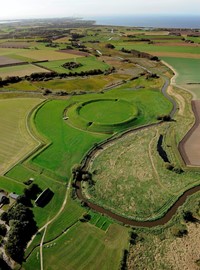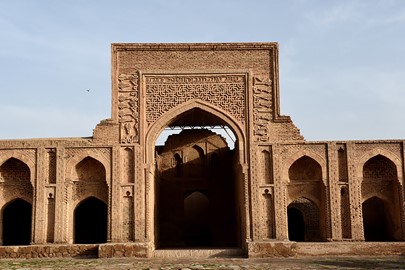category :: cultural
Si Thep
Si Thep, a UNESCO World Heritage site in Thailand’s Phetchabun province, inscribed in September 2023, is an ancient twin-town settlement from the Dvaravati Empire (6th–10th centuries CE). Located 340 km north of Bangkok, it features an Inner and Outer Town with moats, the massive Khao Klang Nok monument, and the Khao Thamorrat Cave, showcasing a blend of Indian-influenced architecture and the distinctive Si Thep School of Art. As Thailand’s seventh UNESCO site, this 1,500-year-old complex highlights its his... Read More
Wooden Hypostyle Mosques
The Wooden Hypostyle Mosques of Medieval Anatolia, a UNESCO World Heritage site in Turkey inscribed in September 2023, comprise five Seljuk-era mosques built between the late 13th and mid-14th centuries across Afyon, Ankara, Eskişehir, Konya, and Kastamonu provinces. Known as “forest mosques,” they feature masonry exteriors and interiors with multiple wooden columns supporting flat ceilings, showcasing exceptional woodcarving and nailless construction techniques. Recognized as Turkey’s 21st UNESCO site, the... Read More
Hopewell Ceremonial Earthworks
The Hopewell Ceremonial Earthworks, a UNESCO World Heritage site in Ohio, USA, inscribed in September 2023, encompass eight monumental complexes built by the Hopewell culture between 1 and 400 CE. Spanning Newark, Chillicothe, and other sites, these geometric enclosures—circles, squares, and octagons—crafted from earth, feature precise astronomical alignments and served as ceremonial hubs for a vast trade network across half of North America. As the USA’s 25th UNESCO site, they showcase pre-Columbian engine... Read More
Khinalig
Khinalig, a UNESCO World Heritage site in Azerbaijan inscribed in September 2023, is a high-mountain village in the Greater Caucasus, recognized for its cultural landscape and the 200-km Köç Yolu transhumance route. Perched at 2,350 meters, this 5,000-year-old settlement is home to the semi-nomadic Khinalig people, who maintain ancient traditions and a unique language while seasonally migrating livestock between mountain summer pastures and lowland winter plains. Featuring stone houses, sacred forest fragme... Read More
Zatec
Žatec and the Landscape of Saaz Hops, a UNESCO World Heritage site in Czechia inscribed in September 2023, is a historic hop-growing region in the Ústí nad Labem area along the Ohře River. Renowned for over 700 years of cultivating the prized Saaz hops, used in beers like Pilsner and Guinness, this site includes the well-preserved medieval town of Žatec, its 19th-century industrial quarter, and surrounding hop fields and villages like Trnovany and Stekník. As the world’s first hop-growing area on the UNESCO... Read More
Maison Carrée of Nîmes
The Maison Carrée of Nîmes, a UNESCO World Heritage site in southern France inscribed in September 2023, is a remarkably preserved Roman temple completed around 7 CE during Augustus’s reign. Located in Nîmes, this 26-by-13-meter structure, built of local limestone with Corinthian columns, originally honored Gaius and Lucius Caesar and exemplifies early Imperial architecture with its perfect proportions and elevated podium. As France’s 50th UNESCO site and one of the world’s best-preserved Roman temples, it ... Read More
Tak’alik Ab’aj
Tak’alik Ab’aj, a UNESCO World Heritage site in Guatemala inscribed in September 2023, is an ancient archaeological park in Retalhuleu, thriving from the 9th century BCE to the 10th century CE. Located along the Pacific coast, this key trade hub blends Olmec and Maya influences, featuring over 240 monuments like stelae, a possible colossal head, and early hieroglyphs across four terraced groups. Recognized as Guatemala’s fourth UNESCO site, it showcases 1,700 years of cultural transition, urban planning, an... Read More
Sacred Ensembles of the Hoysalas
The Sacred Ensembles of the Hoysalas, a UNESCO World Heritage site in India inscribed in September 2023, comprise three 12th–13th-century temples—Chennakeshava in Belur, Hoysaleshwara in Halebid, and Keshava in Somanathapura—in Karnataka. Built by the Hoysala Empire, these masterpieces of Hindu architecture feature intricate soapstone carvings, stellate plans, and sanctuaries dedicated to Vishnu and Shiva, reflecting a peak of artistic and engineering innovation. As India’s 42nd UNESCO site, they highlight ... Read More
Yogyakarta
The Cosmological Axis of Yogyakarta, a UNESCO World Heritage site in Indonesia inscribed in September 2023, is a 6-km north-south corridor in southern-central Java, established in the 18th century by Sultan Mangkubumi. Linking Mount Merapi to the Indian Ocean, it centers on the Kraton (Sultan’s Palace) and includes landmarks like Tugu Monument and Panggung Krapyak, reflecting Javanese cosmological beliefs about life cycles and harmony. As Indonesia’s sixth cultural UNESCO site, this living heritage site sho... Read More
Modernist Kaunas
Modernist Kaunas, a UNESCO World Heritage site in Lithuania inscribed in September 2023, showcases the city’s interwar architecture from 1919 to 1939, when it served as the provisional capital after Vilnius’s occupation. Spanning Naujamiestis (New Town) and Žaliakalnis (Green Hill), this 455-hectare site features over 1,200 buildings blending Art Deco, functionalism, and local styles, reflecting rapid urbanization and national optimism. Recognized as Lithuania’s fifth UNESCO site, it includes landmarks like... Read More
Astronomical Observatories of Kazan Federal University
The Astronomical Observatories of Kazan Federal University, a UNESCO World Heritage site in the Russian Federation, consist of two historic facilities: the Kazan City Astronomical Observatory, built in 1837 on the university campus in central Kazan, and the suburban Engelhardt Astronomical Observatory, established in 1901, 24 kilometers west of the city. Recognized for their contributions to optical astronomy and astrophysics from the 19th and early 20th centuries, these well-preserved sites feature unique ... Read More
Talayotic Menorca
Talayotic Menorca, a UNESCO World Heritage site in Spain, encompasses a series of prehistoric archaeological sites across the Balearic island of Menorca, dating from the Bronze Age (1600 BCE) to the Late Iron Age (123 BCE). These well-preserved sites, set in agro-pastoral landscapes, feature distinctive cyclopean structures—built with large, mortarless stone blocks—including talayots (conical towers), taulas (T-shaped ritual monuments), and navetas (boat-shaped tombs). Recognized for their exceptional densi... Read More
Djerba
Djerba, a UNESCO World Heritage site in Tunisia, is a Mediterranean island renowned for its well-preserved cultural landscape, shaped by over 3,000 years of diverse human settlement. Spanning 514 square kilometers, it features traditional architecture, including whitewashed houses, fortified mosques, and underground oil presses, alongside historic trading hubs like Houmt Souk. Recognized for its unique blend of Berber, Arab, Jewish, and African influences, Djerba’s heritage reflects a resilient agro-pastora... Read More
Gordion
Gordion, a UNESCO World Heritage site in Turkey, is an ancient archaeological site near modern Yassıhöyük, celebrated as the capital of the Phrygian kingdom from the 12th to 7th centuries BCE. Spanning 13 square kilometers, it features a fortified citadel with monumental gates and palaces, extensive tumulus burials—including the famed 'Midas Mound'—and evidence of advanced Iron Age urban planning. Recognized for its historical significance as a political and cultural hub linked to the legendary King Midas, ... Read More
Silk Roads: Zarafshan Karakum Corridor
The Silk Roads: Zarafshan-Karakum Corridor, a UNESCO World Heritage site spanning Tajikistan, Turkmenistan, and Uzbekistan, is an 866-kilometer stretch of the ancient Silk Road, active from the 2nd century BCE to the 16th century CE. This corridor, running along the Zarafshan River and through the Karakum Desert to the Merv Oasis, features 31 sites, including medieval cities, caravanserais, and Sogdian settlements. Recognized for its role in facilitating trade and cultural exchange across diverse landscapes... Read More
Koh Ker
Koh Ker, a UNESCO World Heritage site in Cambodia, is a remote archaeological complex 100 kilometers northeast of Angkor, serving as the Khmer Empire’s capital from 928 to 944 CE under King Jayavarman IV. Spanning 35 square kilometers of dense forest, it features over 180 monuments, including the iconic seven-tiered Prasat Thom pyramid, sculptural lingams, and intricately carved temples. Recognized for its monumental architecture and artistic innovation, Koh Ker reflects a brief but significant shift in Khm... Read More
Tr’ondek Klondike
Tr’ondëk-Klondike, a UNESCO World Heritage site in Canada’s Yukon Territory, is a cultural landscape spanning eight sites along the Yukon and Klondike rivers, centered on Dawson City. Inscribed in 2023, it chronicles the Tr’ondëk Hwëch’in First Nation’s resilience amid the Klondike Gold Rush (1896-1898) and colonial expansion from 1874 to 1908. Featuring Indigenous settlements, trading posts, and mining relics, this 334-hectare area highlights the interplay of Indigenous and newcomer cultures in a subarctic... Read More
Tea Forests of the Jingmai Mountain
The Tea Forests of Jingmai Mountain, a UNESCO World Heritage site in China’s Yunnan Province, is a 1,513-hectare cultural landscape where ancient tea cultivation thrives. Developed over a millennium by the Bulang, Dai, and Hani peoples, it features old-growth tea forests, traditional villages, and sacred groves atop the mist-shrouded Jingmai and Mangjing mountains. Recognized in 2023 for its sustainable agroforestry and unique tea ancestor worship, this site exemplifies a harmonious blend of nature, culture... Read More
Viking Age Ring Fortresses
The Viking-Age Ring Fortresses, a UNESCO World Heritage site in Denmark, consist of five circular fortifications—Aggersborg, Fyrkat, Nonnebakken, Trelleborg, and Borgring—built around 975-980 CE under King Harald Bluetooth. Strategically located across Zealand, Funen, and Jutland, these precisely engineered earthworks, with their uniform design of ramparts, moats, and internal layouts, reflect centralized power and advanced military architecture of the late Viking Age. Recognized in 2023, they highlight Den... Read More
Gedeo Cultural Landscape
The Gedeo Cultural Landscape, a UNESCO World Heritage site in Ethiopia, is a 46,717-hectare agroforestry region in the Gedeo Zone, recognized in 2023 for its sustainable farming traditions and cultural heritage. Nestled on the eastern escarpment of the Ethiopian Rift Valley, it features ancient enset and coffee cultivation, sacred forests, and over 1,000 megalithic stelae erected by the Gedeo people centuries ago. This biodiverse mosaic of terraced slopes and traditional villages showcases a harmonious blen... Read More
Jewish Medieval Heritage of Erfurt
The Jewish-Medieval Heritage of Erfurt, a UNESCO World Heritage site in Germany, comprises three well-preserved landmarks in Erfurt’s historic center: the Old Synagogue (c. 11th century), the Mikveh (c. 13th century), and the Stone House (c. 13th century). Recognized in 2023, these sites showcase the thriving Jewish community of the Middle Ages, featuring one of Europe’s oldest intact synagogues, a ritual bath, and a merchant’s residence with rare artifacts like the Erfurt Treasure. This ensemble reflects c... Read More
Santiniketan
Santiniketan, a UNESCO World Heritage site in India’s West Bengal, is a 37-hectare cultural landscape founded by poet Rabindranath Tagore in 1901 as an experimental school, later evolving into Visva-Bharati University by 1921. Recognized in 2023, it blends traditional Indian architecture with nature-inspired open-air classrooms, reflecting Tagore’s vision of holistic education rooted in creativity, humanism, and harmony with the environment. This rural retreat, surrounded by ashram-style buildings and artis... Read More
Persian Caravanserai
The Persian Caravanserai, a UNESCO World Heritage site in Iran, comprises 54 historic roadside inns spanning the country, recognized in 2023 for their role along ancient trade routes from the Achaemenid era (550-330 BCE) to the 19th century. These fortified structures, strategically spaced 30-40 kilometers apart, feature robust brick and stone architecture with courtyards, stables, and domed halls, offering shelter to travelers and merchants. Exemplifying Persian engineering and cultural exchange, sites lik... Read More
Kuldiga
Kuldīga, a UNESCO World Heritage site in western Latvia, is a well-preserved historic town that evolved from a 13th-century medieval hamlet into a key administrative center of the Duchy of Courland and Semigallia between the 16th and 18th centuries. Recognized in 2023, its old town features authentic Baltic architecture, including log buildings and foreign-influenced styles, alongside the scenic Venta River and Europe’s widest waterfall, Ventas Rumba. This 121-hectare site reflects a unique blend of local a... Read More
Rachid Karami International Fair Tripoli
The Rachid Karami International Fair-Tripoli, a UNESCO World Heritage site in Lebanon, is a 70-hectare modernist complex in Tripoli, designed by Brazilian architect Oscar Niemeyer in 1962. Recognized in 2023 and listed as World Heritage in Danger, it features a distinctive boomerang-shaped exhibition hall and over 15 innovative structures, reflecting Lebanon’s 1960s modernization ambitions. Left unfinished due to the 1975 civil war, this collaboration between Niemeyer and Lebanese engineers stands as a stri... Read More
























